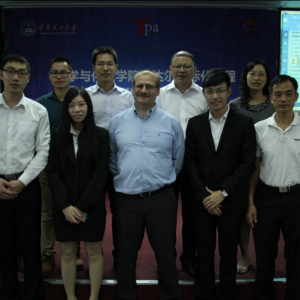答辩现场:

答辩PPT汇总:李国宇.pdf
论文摘要汇总:
李国宇 Abstract In recent years, the chemical industry accidents happen from time to time. Every time it brought huge disaster to the human and the surrounding environment. So, in the new century, we are encouraging enterprises to protect environment and develop sustainably. And the safety has become the main theme of the industry. In order to improve the effectiveness and safety management system, we have invented many different Hazard identification technologies according to the different stages of production. These technologies can complement one another perfectly and help human to improve the safety management’s level. So, to be a college student whose major is Chemical engineering and Technology, it is necessary for us to study the Hazard identification technology deeply. This study focuses on the HAZOP analysis. The study summarized and classified the literature material of the current mainstream Hazard identification technology, then, find out their characteristics and differences. Next, in order to survey the general situation of using Hazard identification technology, the author made a questionnaire. Then, the questionnaire is given out mainly to persons who are engaged in technical related work in chemical industry. So, we can get the real idea that the user thinking about Hazard identification technology. On the basis of research report, the study collected a Chemical Plant’s accident data, and then used the HAZOP to analyze the accident, to find out if the HAZOP analysis is effective. Finally, this paper gives the TOTAL HAZOP report of example. The study shows that the HAZOP analysis method can effectively find out the potential risk, and can prevent the occurrence of chemical accidents in great extent. This thesis summarizes the advantages and disadvantages of HAZOP analysis method. It can provide a reference for the industry using the HAZOP analysis, and give a inspiration to the following research. However, because of the limit of time and materials, we haven’t find out some measures to solve the HAZOP’s disadvantage. So, the following can solve it.
Key words:Hazard identification technology
吴玉芳 Abstract As the major chemical accidents occur frequently, major hazard management has become an important topic all over the world and a series of legislations have appeared. The Seveso Directive in Europe, the OSHA 1910.119 in the USA and legislations including Identification of Major Hazard Installation for Dangerous Chemicals, Interim Provisions on the Supervision and Management of Major Hazards of Dangerous Chemicals, Regulations on the Control over Safety of Dangerous Chemicals, Guidelines for process safety management of chemical corporations and General norms for safety standardization of hazard in China are introduced, respectively. In addition, comparison between these different legislations is made so as to find out the deficiencies in safety management of major hazards in China and perfect the safety management system of major hazards.
Key words :Major hazard, Dangerous chemical, Seveso Directive, Process safety management
姚瀚超 Abstract Petroleum, liquefied petroleum gas (LPG), natural gas and other flammable and explosive organic raw materials, which are often used in the process industry, will quickly form explosive vapor cloud in the transport, storage or transmission with a large leak and will cause the vapor cloud explosions (VCEs) accidents when meeting the fire. VCEs damage the surrounding people and equipment through the explosion shock wave and the explosion thermal radiation thus it is very important to estimate accurately the damage range of VCEs. This paper lists three kinds of common VCE shock wave effect theory model (TNT equivalent model, TNO multi-energy model, Baker-Strehlow model) and a common VCE thermal radiation effect theory model (the universal fireball model and thermal radiation formula proposed by Bake et al). This paper also obtains several results as the main reasons of different accidents by comparing the forecasts of the different VCE models, presents a data analysis of an example of VCE, collects several VCE accidents in China occurred in the process industry, and puts forward some constructive suggestions and preventive methods.
Keywords:VCEs; TNT model; TNO model; Baker-Strehlow model; the thermalradiation effects; process industry; Xi’an VCE | 




